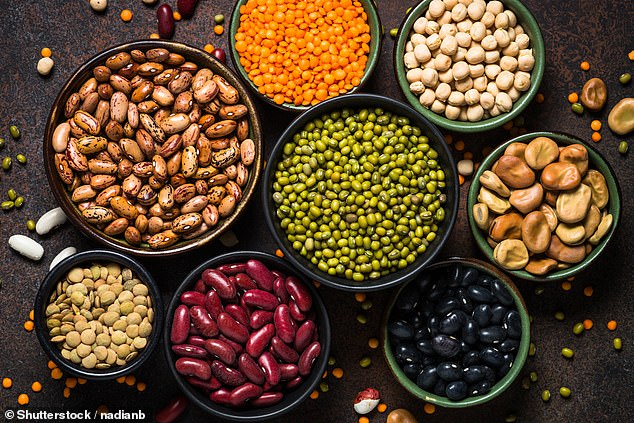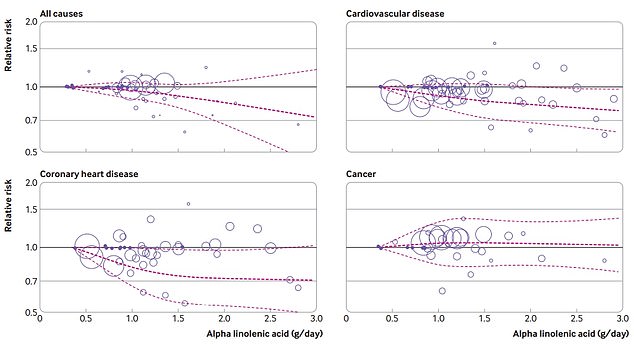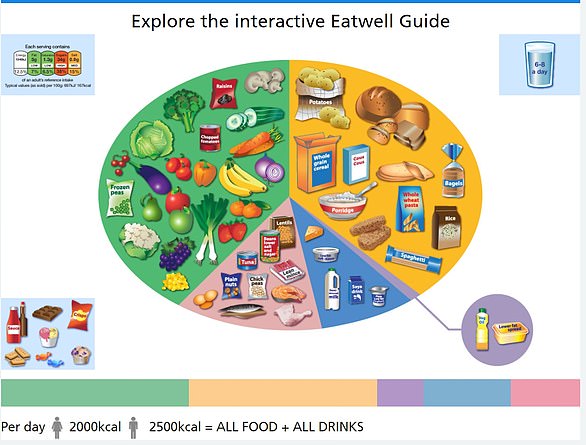Eating lots of nuts, seeds and plant oils may cut your risk of being sent to an early grave, scientists say.
Iranian researchers reviewed dozens of studies that delved into diets and mortality rates, spanning up to three decades.
They specifically looked at the effects of alpha-linolenic acid (ALA) — an omega-3 found in plants such as soy beans and flaxseeds.
Results showed people with a high intake of the nutrient — around 1.6g a day — were 10 per cent less likely to die from any cause, compared to those who consumed the lowest amounts — around 0.7g.
Deaths from heart disease were also lower among people who ate a diet rich in nuts and other ALA-abundant foods.
For every 1g increase in ALA per day – around one tablespoon of canola oil – the risk of dying from cardiovascular disease fell by five per cent, the study claimed.
However, the review also showed consuming high amounts of ALA was linked to an increased risk of dying from cancer.
The study, published in the British Medical Journal, states further trials are needed to confirm the link.
Cardiovascular disease – the world’s biggest killer – is behind 160,000 deaths in the UK every year and 659,000 in the US.

Alpha-linolenic acid – an omega-3 found in plants such as soy beans, nuts and flaxseeds – was found to slash the risk of overall death, as well as the risk of dying from heart and blood vessel disease

The graphs show how alpha-linolenic acid (ALA) – an omega-3 found in plants such as soy beans, nuts and flax seeds – intake affects the risk of death from all causes (top left), cardiovascular disease (top right), coronary heart disease (bottom left) and cancer (bottom right). A high intake of ALA was linked with a 10 per cent drop in risk of death, 11 per cent decline in the chance of dying from coronary heart disease and an eight per cent drop in the risk of dying from cardiovascular disease. However, the findings suggest the seeds could be linked with a slight uptick in risk from cancer, but cautioned more studies would be needed to confirm this
Earlier studies found ALA was linked with a lower risk of fatal coronary heart disease — one type of cardiovascular disease.
But a raft of others were inconclusive on whether the nutrient improved mortality.
To address the uncertainty, the Tehran University of Medical Sciences team analysed results from 41 studies published between 1991 and 2021.
In total, the studies included 1.2million adults – mostly from western countries – who were monitored for between two and 32 years.
Some 198,113 deaths were recorded, 62,773 of which were caused by cardiovascular disease, while 65,954 were due to cancer.
The review found adults who ate lots of ALA-rich foods were 10 per cent less likely to die from all causes – equivalent to 113 fewer deaths per 10,000 person-years.
And it reduced the chance of dying from cardiovascular disease by eight per cent – which would lead to around 33 fewer deaths per 10,000 person-years.
Sina Naghshi and colleagues also spotted the more ALA a person consumed, the less likely they were to die from cardiovascular disease.
There were 63 extra cancer fatalities per 10,000 person-years among those who ate the highest amounts of the omega-3, compared to those who ate the least.
The review was observational, so cannot conclude that ALA consumption definitely fuelled the improvements or cancer risk.
But researchers believe their findings are ‘robust’, and bragged that they add to the ‘evidence of the potential health benefits of polyunsaturated fatty acids’.
Experts believe ALA helps heart health by reducing cholesterol and improving blood pressure.
They said further studies should examine the link between ALA and other causes of death to determine if it can be linked with reducing the risk of dying from any other causes.
Experts should also look into specific ALA-rich foods to see if how the omega-3 is consumed affects mortality rates.
They warned any recommendations to eat more ALA should be made ‘cautiously’ due to their finding of a possible link with cancer.
WHAT SHOULD A BALANCED DIET LOOK LIKE? 
Meals should be based on potatoes, bread, rice, pasta or other starchy carbohydrates, ideally wholegrain, according to the NHS
• Eat at least 5 portions of a variety of fruit and vegetables every day. All fresh, frozen, dried and canned fruit and vegetables count
• Base meals on potatoes, bread, rice, pasta or other starchy carbohydrates, ideally wholegrain
• 30 grams of fibre a day: This is the same as eating all of the following: 5 portions of fruit and vegetables, 2 whole-wheat cereal biscuits, 2 thick slices of wholemeal bread and large baked potato with the skin on
• Have some dairy or dairy alternatives (such as soya drinks) choosing lower fat and lower sugar options
• Eat some beans, pulses, fish, eggs, meat and other proteins (including 2 portions of fish every week, one of which should be oily)
• Choose unsaturated oils and spreads and consuming in small amounts
• Drink 6-8 cups/glasses of water a day
• Adults should have less than 6g of salt and 20g of saturated fat for women or 30g for men a day
Source: NHS Eatwell Guide
Advertisement
Source link : https://www.dailymail.co.uk/health/article-10085153/High-intake-fatty-acid-nuts-seeds-plant-oils-linked-lower-risk-death.html











